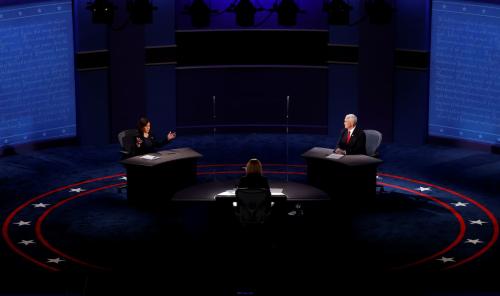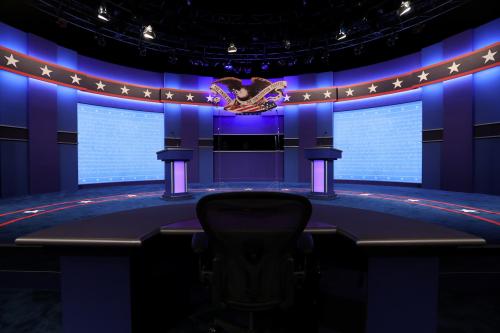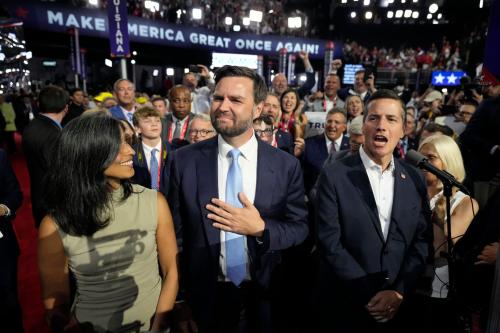As the polls between Donald Trump and Hillary Clinton close, the stakes for the first presidential debate are increasing by the hour. And no wonder. For millions of Americans, this will be their first chance to see the candidates side by side. But of equal if not greater importance will be the days that follow the debate: the fact-checking, the results of real time polling of focus groups, the spin from the candidates’ camps and the constant analysis from the chattering classes. So before that first debate of 2016, let’s take a quick look back at past presidential debates and at some of the things we’ve learned from them.
Rule #1: Look good on camera.
The first presidential debate of the television era was the 1960 debate between Senator John F. Kennedy and Vice President Richard Nixon. It is famous primarily for the fact that the intimate experience of television opened up a whole new element to debates—how people looked and how they came across to the viewers. Kennedy was young, handsome, made up for television and rested. Nixon, while also young, didn’t look it, appearing tired, sick, shifty-eyed and without make-up. The difference was dramatic. In a story that is now the stuff of legend, those who heard Nixon on radio thought he had won, those who watched on television thought Kennedy had won.
The first televised debate proved that the political class was, indeed, in uncharted waters. Is it any wonder that following the 1960 debates it took another sixteen years before presidential candidates agreed to debate each other on television? The next presidential debates took place in 1976 between then-Governor Jimmy Carter of Georgia and incumbent President Gerald Ford.
If Rule #1 of presidential debating—look good on camera—had been learned in 1960 – Rule #2 was learned in 1976—don’t make mistakes that reinforce the negative narrative of your candidacy. But Gerald Ford did just that.
Rule #2: Don’t make mistakes that reinforce the negative narrative of your candidacy.
Ford was an “accidental” president, having been appointed vice president to President Nixon when Nixon’s first vice president resigned in scandal, and succeeding to the presidency when Nixon himself resigned after being impeached. His pardon of Nixon didn’t win him many friends among the voters and the humble, straight-talking Governor from Georgia probably would have been elected regardless of the debates.
But in his short presidency Gerald Ford had gotten himself a reputation as somewhat of a stumblebum. After a fall coming down the steps of Air Force One in Austria and again going up the steps of Air Force One in Michigan, Chevy Chase, one of the stars of (at that time) the new television show called Saturday Night Live began to make fun of the president by taking some truly spectacular falls.
And so, when President Ford, in his second debate against Governor Carter stated, not once, but twice that “There is no Soviet domination of Eastern Europe,” the statement was not only factually wrong but it played into the narrative of Ford’s presidency: an accidental president who was accident prone—physically and intellectually.
In 1980 there was only one presidential debate between President Jimmy Carter and Governor Ronald Reagan. Carter had refused to participate in an earlier debate because the organizers had included an independent candidate, former congressman John Anderson. So the October 28 debate was the one and only debate between the two and it was a fateful debate. Although we remember the 1980 election as a huge landslide for Reagan, it was not a foregone conclusion. Going into September, the President had a modest lead of 38 to 35 percent over Reagan. By the first debate, the one he did not participate in, Carter’s lead was 40 to 36 percent. But after the first debate which Carter skipped, the polls reversed and Reagan opened up a modest lead over Carter which grew to 6 points in the week before their one and only debate.
Jimmy Carter’s presidency had been fraught with problems. The economy was in awful shape, a military mission to rescue American hostages in Tehran had failed and Carter himself was seen as inept and not in control of events. Nonetheless, for many months the 1980 race was close because Ronald Reagan had acquired a reputation as a war monger, someone who was capable of launching a first-strike nuclear attack, someone who many felt could not be trusted as Commander in Chief. (Sound familiar?)
Rule #3: If the narrative going in is negative, try and use the debate to turn it around.
But in the one and only debate prior to the 1980 election Ronald Reagan was as relaxed and amiable as Kennedy had been twenty years before—being an actor he was comfortable with the camera. Whenever President Carter criticized him he responded with a smile and an avuncular “There you go again.” And when he looked into the camera and asked Americans “Are you better off than you were four years ago,” the election was over. Seven days later Reagan won a landslide victory with 51 percent of the popular vote versus 41 percent for Carter and 489 electoral votes. All along Pat Caddell, the President’s pollster had told the campaign that their best hope was to keep from seriously considering Reagan as president—the “plausibility threshold.” “That night,” recalls Carter’s aide Hamilton Jordan, “it looked as if Reagan had marched across it.” And so Rule #3 of presidential debates—if the narrative going in is negative, try and use the debate to turn it around.
Rule #4: Sometimes a clever line, well delivered, can get you out of trouble.
Four years later, President Reagan found himself facing Jimmy Carter’s vice president Walter Mondale in the presidential debates. The election itself was never really in doubt. The country had recovered from the recession and growth was strong. As one of Reagan’s most popular television ads said, it was “morning in America” once again. And so Walter Mondale had a tough climb before him when he took the stage on October 7, 1984 for his first debate against President Reagan. But Reagan seemed disoriented. In 1984 he was 73 years old, and questions about his age were hotly debated for the two weeks in between debates and raised among Democrats a glimmer of hope that maybe, just maybe, Mondale could win. At one point in the first debate the camera showed Walter Mondale staring at him—a quizzical look on his face. On leaving the stage Mondale was heard to say, “This guy is gone.”
But when he was pressed about his age in the second debate, Reagan delivered a line so flawless and spot-on that, for all practical purposes, it ended the election. “I am not going to exploit for political purposes my opponent’s youth and inexperience.” The audience erupted in howls of laughter and even Walter Mondale had to laugh—before he cried. In spite of his clear confusion in other moments, this one-liner ruled the day. Thus Rule #4 of presidential debates—sometimes a clever line, well delivered, can get you out of trouble.
By the time President George W. Bush came to debate Governor Michael Dukakis of Massachusetts in the 1988 campaign the debates had become institutionalized. A commission was formed in 1987 to sponsor them and negotiate everything from dates to staging with the presidential campaigns. Crime was one of the major issues in the 1988 election. The Bush campaign was busy developing a narrative about Dukakis that alleged he was “soft” on crime. They had dug up the story of Willy Horton, a convicted rapist who was let out of a Massachusetts jail on a furlough program and raped and murdered someone else while out. Since this happened while Dukakis was Governor and since Dukakis was against the death penalty, the issue had assumed great import during the campaign.
Rule #5: Answer questions as a warm-blooded human being first, and a policy wonk second.
And so, in the first debate, moderator Bernard Shaw of CNN opened with a question to Dukakis, “Governor, if Kitty Dukakis were raped and murdered, would you favor an irrevocable death penalty for the killer?” The question was shocking enough and its appropriateness debated by many in the days after the debate. Despite this, it was not Shaw’s question, that proved to be the lasting moment of the night—it was Dukakis’ answer. With no show of emotion, he went straight into a legal and policy defense of his opposition to the death penalty. The question, coupled with the cold-bloodedness of the answer prompted the journalist Walter Shapiro to write “The question was in ghoulish taste, but it proved revealing.”And so we arrive at Rule #5 of presidential debates—answer questions as a warm-blooded human being first, and a policy wonk second.
One of the ironies of the next presidential debate in 1992 is that the man who defeated Michael Dukakis would also prove himself to be “empathy-challenged.” In a memorable moment from the second debate with his Democratic opponent, then-Governor Bill Clinton, President George H. W. Bush was caught on camera looking at his watch—as if to indicate that he had better things to do with his time. If that wasn’t bad enough, an African-American woman from the audience asked both candidates how the recession had affected them. Bush went immediately on the defensive. As a wealthy man, the recession hadn’t affected him at all. And as he tried to answer the question he dug himself further and further into a hole. He was followed up by Clinton, who walked right up to the woman and—in a gesture he was to become famous for—“felt her pain.”The difference couldn’t have been clearer. Rule #6 of presidential debates is similar to Rule #5—empathy matters.
Rule #6: Empathy matters.
https://www.youtube.com/watch?v=hBrW2Pz9Iiw
In 2000, Clinton’s Vice President, Al Gore, won the Democratic nomination and then faced Texas Governor George W. Bush in the fall debates. Bush had proved himself to be a genial, if somewhat unprepared presidential candidate—the guy who didn’t seem to know the names of foreign leaders or foreign capitals, but the guy who everyone wanted to have a beer with. Expectations were high for Al Gore who, as vice president, had eviscerated Ross Perot in a debate on trade in 3,1993 and low for George W. Bush, who basically had to get through the night without making the sort of major factual mistake President Ford had made fourteen years earlier. Bush came through the debate pretty much unscathed, but Gore made a brand new kind of mistake in the first debate. Thinking that the television cameras weren’t on him, he grimaced, shook his head and sighed in a combination of disgust and disagreement as Bush was talking. And in an effort to convey his commitment to keeping social security safe for the future he used the analogy of putting the trust fund into a “lockbox,” a phrase he repeated probably once too often.
The results were brutal. In spite of the fact that Gore had a more secure grasp of the issues than Bush, audiences reacted poorly to what seemed to be his overly aggressive stance. He was subjected to the merciless satire of Saturday Night Live, whose satire on his debate performance was shown to Gore to illustrate where he had gone wrong.
Rule #7: Don’t ever assume the camera is not on you.
Rule #7: Don’t ever assume the camera is not on you.
Of course not all presidential debates have memorable moments. The 2004 and 2012 debates were similar in that the incumbent Presidents Bush and Obama, were clearly off their game in their first debates, perhaps feeling that somehow this was not what they were being paid to do. But in spite of bad first debates, they recouped and they each won re-election.
And so as we look towards the first debate of 2016—how do the rules above apply?
First, both candidates and their campaigns will take care to make their candidate look as good as possible on television. No one will ever repeat Richard Nixon’s mistakes—refusing makeup, wearing a light colored suit, being visibly exhausted- ever – again. Everything from camera angles, lighting, make up, hair and wardrobe, will be meticulously negotiated and planned.
Second, both Clinton and Trump will be aware of their negative narratives and will try not feed into them. For Trump, that means tamping down his inclination towards the provocative and sensational kinds of statements that have made people wonder if he has the temperament to be president. For Hillary it means showing a softer, more personal side. Hillary, a true policy wonk, is particularly vulnerable to violating Rule #5—making the Michael Dukakis mistake and going right to the policy, bypassing the human. Trump, however, is more likely to break Rule #2 and have a Gerald Ford-like mistake, saying something that is simply wrong and that plays into people’s preconceptions about him.
The candidates will also try to reverse the negative narratives. Hillary will smile a lot, Trump will try not to bully. And they will both be acutely aware that the camera is on them. All the time.
The toughest part of the debates however is to create a “moment” that will sink into the public consciousness. Ronald Reagan managed that in 1980—moving a six point race to a ten point victory in just about a week. Included in the excessive care that now goes into prepping for these debates is the hope that maybe, just maybe—lightning might strike.
Elaine C. Kamarck is a Senior Fellow at the Brookings Institution and author of Primary Politics: Everything You Need to Know about How America Nominates Its Presidential Candidates. She is a superdelegate to the Democratic convention.
The Brookings Institution is committed to quality, independence, and impact.
We are supported by a diverse array of funders. In line with our values and policies, each Brookings publication represents the sole views of its author(s).








Commentary
Seven rules for presidential debates drawn from history
September 22, 2016